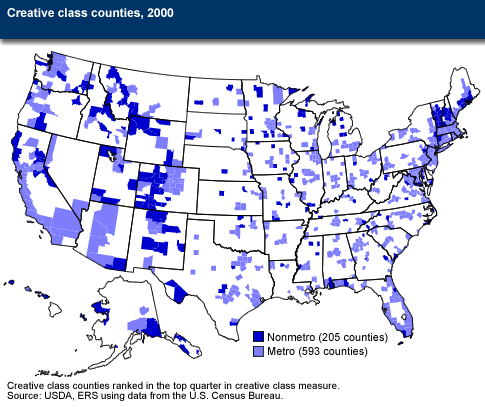Overview
Richard
Florida's Rise of the Creative Class makes a compelling
argument that urban development now depends on novel combinations
of knowledge and ideas, that certain occupations specialize in
this task, that people in these occupations are drawn to areas
providing a high quality of life, and that the essential development
strategy is to create an environment that attracts and retains
these workers. While developed with urban areas in mind, this
thesis may be particularly relevant in rural areas, which lose
much of their young talent as high school graduates leave for
college, the armed forces, or "city lights."
Our analysis
of recent development in rural U.S. counties, which focuses
on natural amenities as quality-of-life indicators, supports
the creative class thesis. A repetition for urban counties
also shows a strong relationship between creative class presence
and growth, although natural amenities play a smaller role. However,
our results depend on a recast creative class measure, which
excludes from the original Florida measure many occupations
with low creativity requirements and those involved primarily
in economic reproduction (i.e., numbers proportional to population).
Our measure conforms more closely to the concept of creative
class and proves to be more highly associated with regional development
than the original Florida measure.
Other work by Florida has demonstrated that a critical subset of the creative class is that comprised of fine, performing, and applied artists. His "Bohemian index"—the share of employment in arts occupations—is strongly associated with new firm formation and high-tech specialization in metropolitan areas. The creative class codes data file also breaks out the share of employment in the arts.
The data sources and process of defining county-level
creative class codes are described in the documentation.

Data Files
| County-level
creative class codes, 1990 and 2000 |
 |
Data table—Variables
used to construct the ERS creative class measure include number
and percent employed in creative class occupations and a metro/nonmetro
indicator for all counties, 1990 and 2000. A break-out of employment
in the arts is included. |
Data Documentation and Methods
Get details about how the measure is
constructed, and examples of its use in research.
Related Resources
Related Links
|



